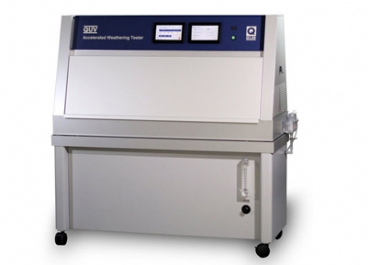咨询热线
18566398802ASTM G154测试标准
-> ASTM G154标准介绍
-> 符合ASTM G154的仪器
ASTM G154标准介绍
ASTM G154是使用荧光紫外线设备对非金属材料进行曝露的测试方法,现行最近版本的为2016修订的ASTM G154-16标准。
ASTM G154是使用荧光紫外灯和冷凝装置进行曝露测试的基本原则和操作程序,旨在再现材料曝露在阳光下(直接或透过窗玻璃)和曝露在湿气中(雨水或露水)发生的老化效果。
QUV紫外老化试验箱用于ASTM G154 Cycle1的测试方法

QUV紫外老化试验箱用于ASTM G154 Cycle1的测试方法
QUV紫外老化试验箱用于ASTM G154 Cycle2的测试方法

QUV紫外老化试验箱用于ASTM G154 Cycle2的测试方法
QUV紫外老化试验箱用于ASTM G154 Cycle3的测试方法

QUV紫外老化试验箱用于ASTM G154 Cycle3的测试方法
ASTM G154 标准英文版本(摘抄)
1. Scope
1.1 This practice is limited to the basic principles for operating a fluorescent UV lamp and water apparatus; on its own, it does not deliver a specific result.
1.2 It is intended to be used in conjunction with a practice or method that defines specific exposure conditions for an application along with a means to evaluate changes in material properties. This practice is intended to reproduce the weathering effects that occur when materials are exposed to sunlight (either direct or through window glass) and moisture as rain or dew in actual usage. This practice is limited to the procedures for obtaining, measuring, and controlling conditions of exposure.
Note 1: Practice G151 describes general procedures to be used when exposing nonmetallic materials in accelerated test devices that use laboratory light sources.
Note 2: A number of exposure procedures are listed in an appendix; however, this practice does not specify the exposure conditions best suited for the material to be tested.
1.3 Test specimens are exposed to fluorescent UV light under controlled environmental conditions. Different types of fluorescent UV lamp sources are described.
Note 3: In this standard, the terms UV light and UV radiation are used interchangeably.
1.4 Specimen preparation and evaluation of the results are covered in ASTM methods or specifications for specific materials. General guidance is given in Practice G151 and ISO 4892-1.
Note 4: General information about methods for determining the change in properties after exposure and reporting these results is described in ISO 4582 and Practice D5870.
1.5 The values stated in SI units are to be regarded as standard. No other units of measurement are included in this standard.
1.6 This standard does not purport to address all of the safety concerns, if any, associated with its use. It is the responsibility of the user of this standard to establish appropriate safety and health practices and determine the applicability of regulatory limitations prior to use.
1.7 This standard is technically similar to ISO 4892-3 and ISO 16474-3.
2. Referenced Documents
ASTM Standards
D5870 Practice for Calculating Property Retention Index of Plastics
D6631 Guide for Committee D01 for Conducting an Interlaboratory Study for the Purpose of Determining the Precision of a Test Method
G113 Terminology Relating to Natural and Artificial Weathering Tests of Nonmetallic Materials
G151 Practice for Exposing Nonmetallic Materials in Accelerated Test Devices that Use Laboratory Light Sources
G177 Tables for Reference Solar Ultraviolet Spectral Distributions: Hemispherical on 37 Tilted Surface
ISO Standards
ISO 16474-3 Paints and VarnishesMethods of Exposure to Laboratory Light SourcesPart 3: Fluorescent UV Lamps
ISO4582 PlasticsDetermination of the Changes of Colour and Variations in Properties After Exposure to Daylight Under Glass, Natural Weathering or Artificial Light
ISO4892-1
